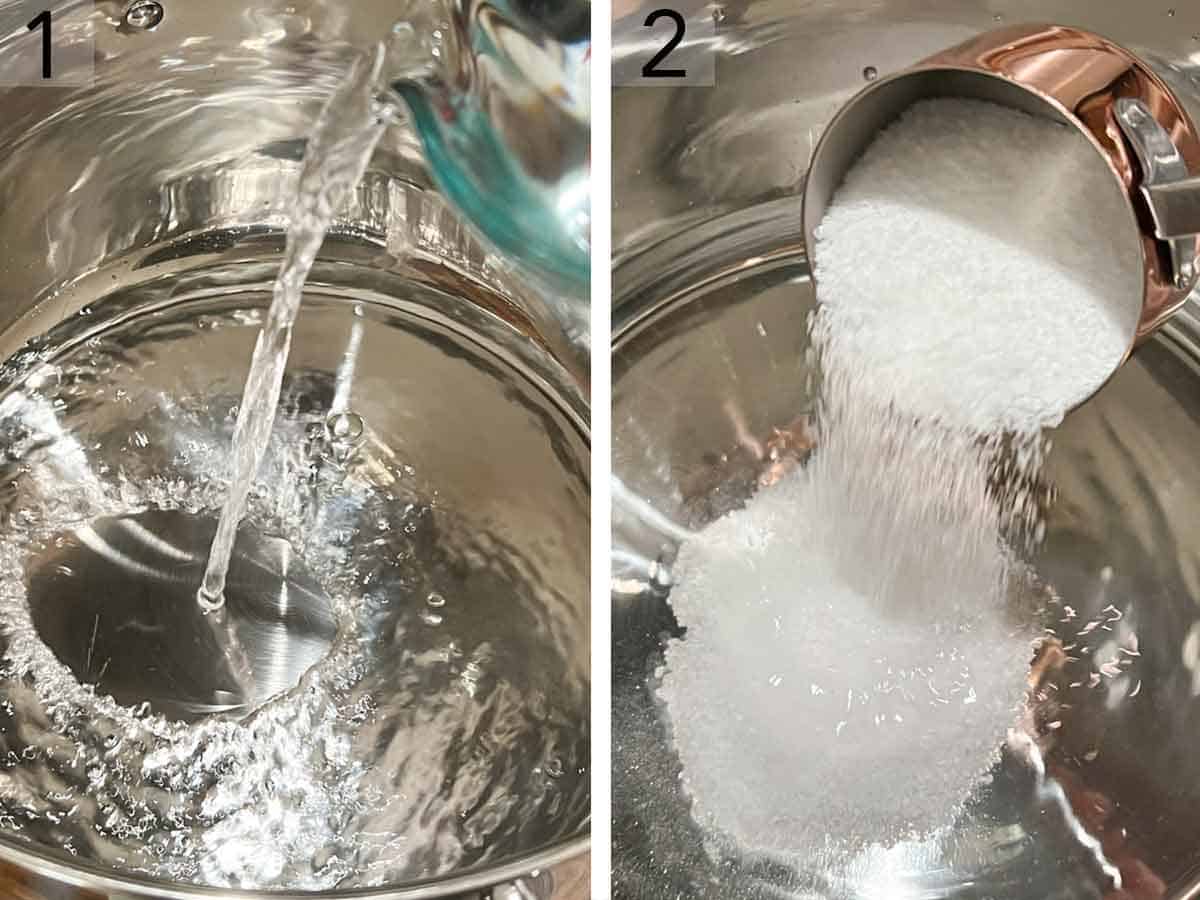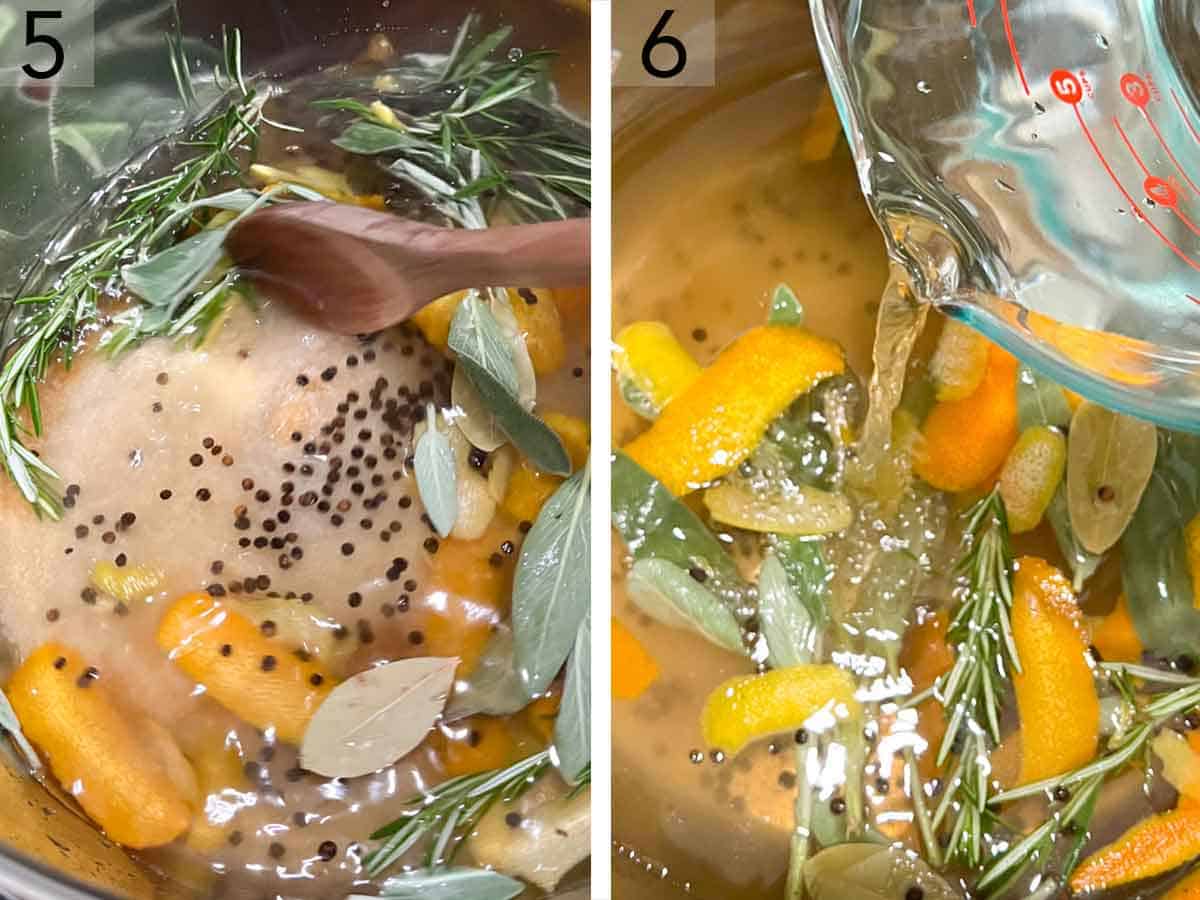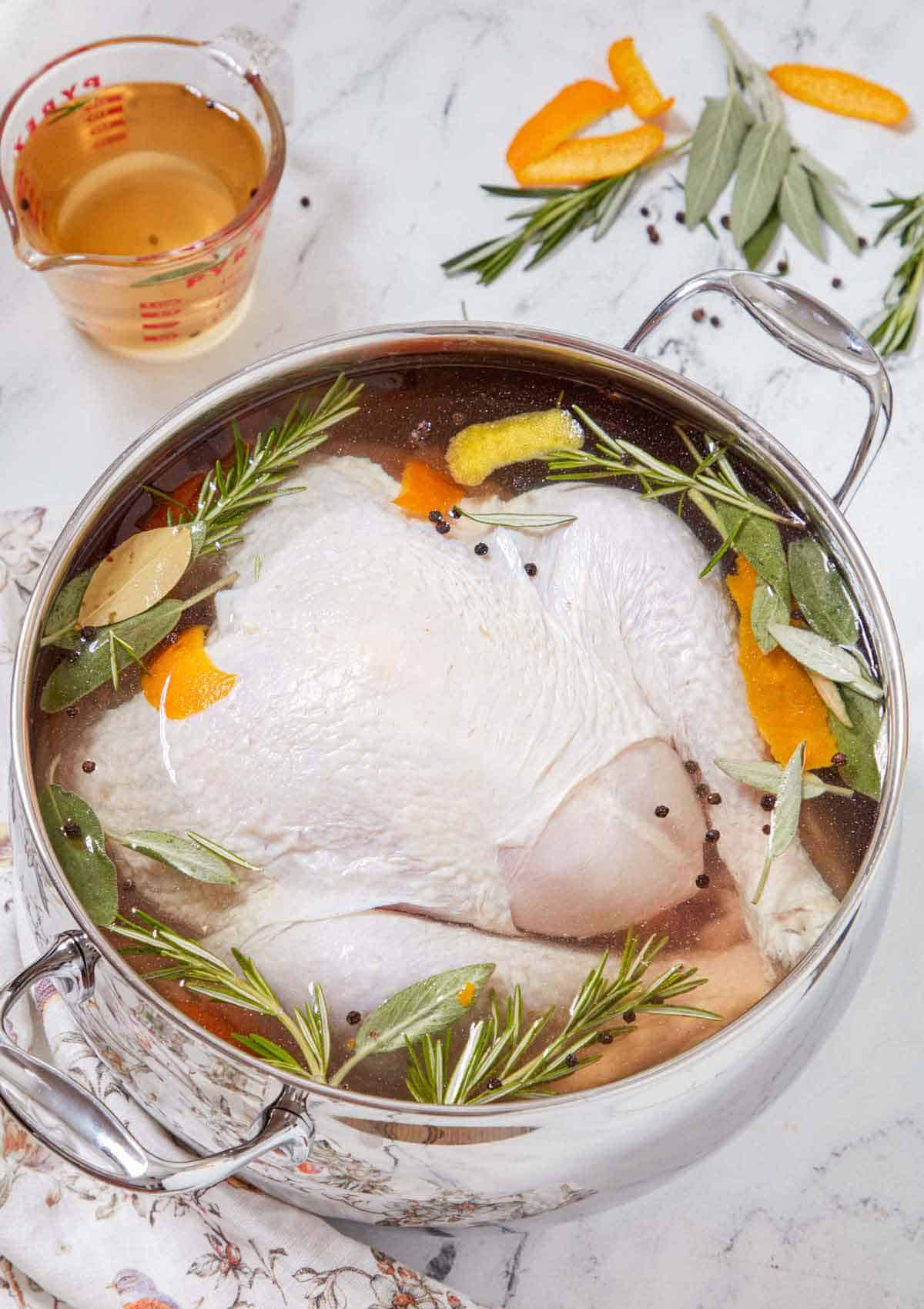If you’ve never brined a Thanksgiving turkey before, then you are missing out on amazing flavors and a super moist bird. Making a brine for a turkey may seem like an extra step you can skip, but I promise you, its a quick step that takes your turkey and Thanksgiving dinner the next level.
There are two types of brines: dry brine and wet brine. A dry brine is a salt and spice combination rubbed over the turkey and set in the fridge for at least 24 to 48 hours, whereas with a wet brine, you do the same, but you add the salt and spices to water, and then submerge the turkey in it. A wet brine works more quickly as it takes under 24 hours.
A turkey is a naturally lean protein without a lot of fat which means it’s prone to drying out. However, when you brine a turkey, it absorbs some of the liquid and aromatics, which is the best way to keep the bird moist and season it throughout. Brining also gives you some extra wiggle room, so if you accidentally overcook the turkey, it’ll still remain moist and tender.
Need more ideas for your next holiday dinner? Try my smashed potatoes recipe, cornbread dressing recipe, or mashed potatoes recipe.
What You Need to Make This Recipe

Salt — this brine uses kosher salt. I do not suggest swapping kosher salt for table salt as table salt is denser and doesn’t measure the same way, meaning you will oversalt if you use the same amount.
Sugar — the brown sugar adds sweetness to the brine. This is actually a great time to use any lumpy brown sugar you may have as it dissolves into the brine.
Citrus — adding orange and lemon peel is the key to a flavorful turkey brine as it imparts a light citrus flavor and sweetness to the brine.
Herbs — I use fresh sage and rosemary, but you can use your favorite fresh herb combination. Try thyme, marjoram, tarragon, parsley, or oregano.
Garlic — smashing the garlic cloves will help them impart flavor. No need to mince or chop them!
Peppercorns — make sure to use whole peppercorns and not ground pepper for the freshest aroma and taste.
How to Brine a Turkey

1. In a large pot that is at least 4-quart, add 4 cups of cold water.
2. Combine the water with the salt and sugar. Place over medium-high heat and bring to a simmer, stirring occasionally, just until the salt and sugar are dissolved. Remove the salt solution from the heat.

3. Peel the orange and lemon zest into strips using a vegetable peeler.
4. Add to the pot along with the rosemary, sage, garlic, bay leaves, and peppercorns.

5. Stir to combine.
6. Stir in the remaining 12 cups of water. Let cool to room temperature. Submerge the raw turkey in the brine solution, or put it in a large brining bag or cooler and pour the brine over the top. Cover, and refrigerate for up to 24 hours. Before roasting, remove the turkey and discard the brine. Pat the turkey dry with paper towels, and continue with roasting instructions.

Pro Tips for Making This Recipe
- Before you brine a turkey, check to make sure it’s not already pre-brined or treated with salt. Always check the label and avoid turkeys that are labeled “kosher,” “enhanced,” “basted,” or “self-basted.”
- This recipe works best with a 10- to 15-pound turkey. For larger turkeys, double the brine recipe.
- A smaller 10- to 15- pound turkey usually fits in a big stock pot. If you don’t have a large enough pot or are cooking a very large turkey (20+ pounds), you can buy a small disposable cooler, large cooler, or use a new 5-gallon bucket. You can also often find plastic turkey brining bags in grocery stores around the holidays.
- Always allow the brine to cool to room temperature or have it chilled before placing the bird in. Never put the turkey into a hot brine, as that will partially cook the turkey.
- Make sure you have enough fridge space before starting, as the turkey requires refrigeration as it brines. Do not brine at room temperature.
- Be sure to pat dry the turkey after discarding the brine. Doing so ensures the turkey gets a crispy skin as it roasts.
- This easy turkey brine recipe is not only for a whole turkey! You can use this method to brine a whole chicken or even turkey parts. You can cut down the brine by half if you are only planning to brine the turkey breast or thighs.
- Sometimes the turkey will try to float to the top of the pot of brine. You can try to weigh it down with a large bag of ice. If the liquid doesn’t fully cover the turkey due to floating, be sure to rotate the bird at the halfway mark.

Frequently Asked Questions
I suggest leaving turkey in brine for at least 8 hours in the fridge but no more than 24 hours. If you have a smaller turkey, you can brine it for less. Keep in mind that if you over-brine the turkey, it can make it taste too salty and turn the texture spongy.
I do not recommend reusing the brine to prevent any cross-contamination. Discard turkey brine after one use.
I recommend you fully thaw the turkey before starting the brining process. While it can be a tiny bit frozen, as it’ll finish thawing as it brines, keep in mind that any liquid released will dilute the brine and that the brine will have difficulties penetrating the turkey if it’s frozen.
I love using fresh herbs, but if you do not have any on hand, you can swap the fresh sage and rosemary for their dried counterparts. Use at least 1 teaspoon of dried herbs for every fresh sprig.
You can make gravy, but remember that the drippings from a wet brined turkey will be on the saltier side. You can balance the saltiness by using no-salt broth or adding a little bit of the dippings at a time and tasting as you go.
If you’ve tried this Turkey Brine recipe, then don’t forget to rate the recipe and let me know how you got on in the comments below, I love hearing from you!

Turkey Brine
Equipment
- Large Pot
- Cooler, brining bag, or bucket (optional)
Ingredients
- 1 gallon water divided (3.8L)
- 1 cup kosher salt (384g)
- ½ cup brown sugar (110g)
- 2 oranges
- 2 lemons
- 6 sprigs fresh rosemary
- 6 sprigs fresh sage
- 6 garlic cloves smashed
- 2 bay leaves
- 2 tablespoons whole peppercorns
Instructions
- In a large pot, combine 4 cups of water, salt, and sugar. (If you have a pot big enough to fit your turkey in, use it. If not, any 4-quart pot will work.) Place over medium-high heat and bring to a simmer, stirring occasionally, just until the salt and sugar are dissolved. Remove from the heat.
- Peel the orange and lemon zest in strips using a vegetable peeler. Add to the pot along with the rosemary, sage, garlic, bay leaves, and peppercorns. Stir in the remaining 12 cups of water. Let cool to room temperature.
- Submerge the turkey in the brine, or put the turkey in a large brining bag or cooler and pour the brine over the top. Cover, and refrigerate for up to 24 hours.
- Before roasting, remove the turkey and discard the brine. Pat the turkey dry, and continue with roasting instructions.
Notes
- Before you brine a turkey, check to make sure it’s not already pre-brined or treated with salt. Always check the label and avoid turkeys that are labeled “kosher,” “enhanced,” “basted,” or “self-basted.”
- This turkey brine recipe works best with a 10- to 15-pound turkey. For larger turkeys, double the recipe.
- A smaller 10- to 15- pound turkey usually fits in a big stock pot. If you don’t have a large enough pot or are cooking a very large turkey (20+ pounds), you can buy a small disposable cooler or use a new 5-gallon bucket. You can also often find plastic turkey brining bags in grocery stores around the holidays.
- Always allow the turkey brine to cool to room temperature or have it chilled before placing the bird in. Never put the turkey into a hot brine, as that will partially cook the turkey.
- Make sure you have enough fridge space before starting, as the turkey requires refrigeration as it brines. Do not brine at room temperature.
- Be sure to pat dry the turkey after discarding the brine. Doing so ensures the turkey gets a crispy skin as it roasts.
- This brine is not only for a whole turkey! You can use this method to brine a whole chicken or even turkey parts. You can cut down the brine by half if you are only planning to brine turkey breasts or thighs.
- Sometimes the turkey will try to float to the top of the pot of brine. You can try to weigh it down with a large bag of ice. If the liquid doesn’t fully cover the turkey due to floating, be sure to rotate the bird at the halfway mark.


















Leave a Reply